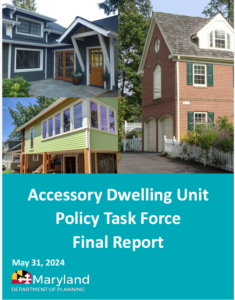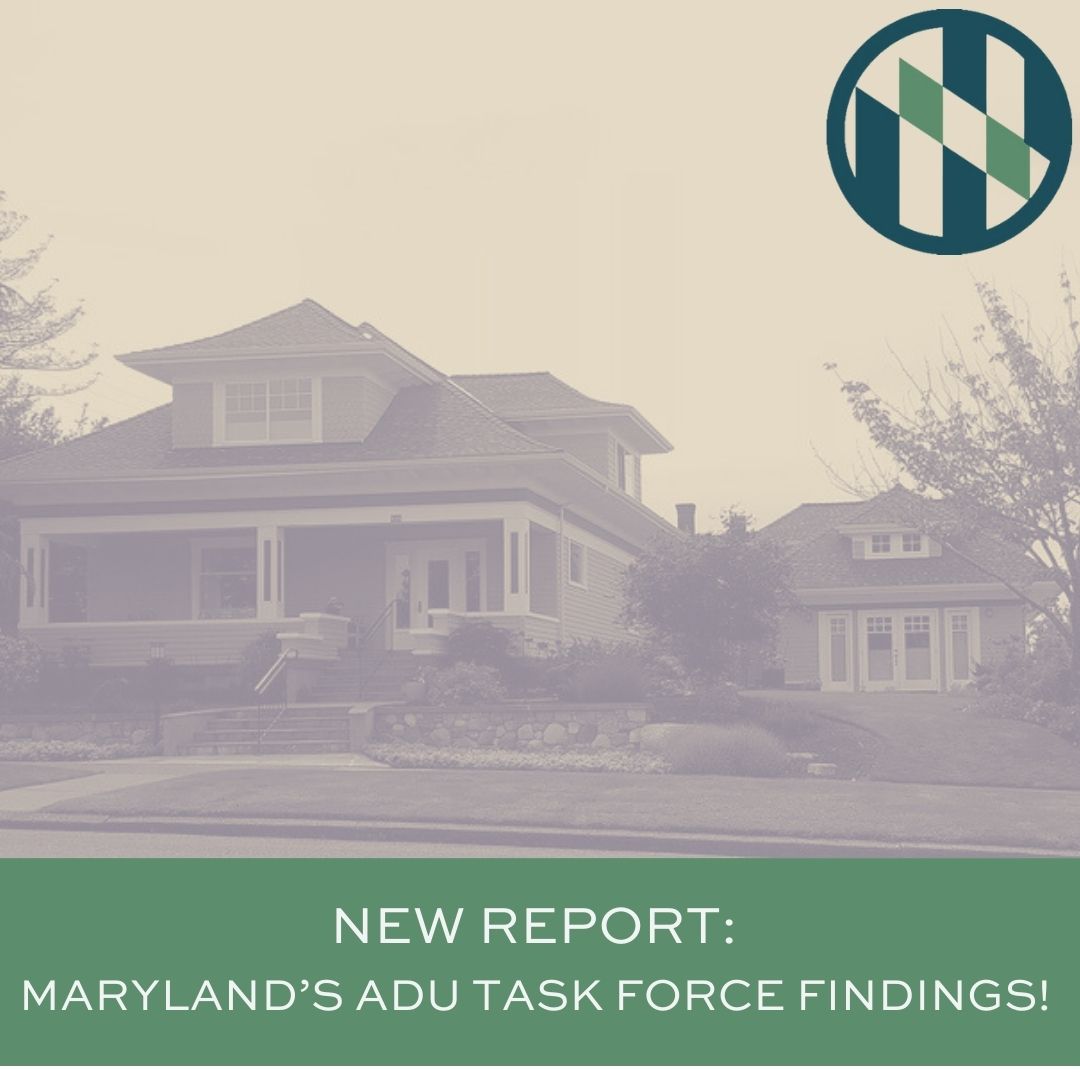
With the passage of SB 382 in the 2023 legislative session, Maryland paved the way to understand accessory dwelling units as a solution to the housing shortage. The Maryland ADU Task Force, chaired by Maryland Department of Planning (MDP) Secretary Rebecca Flora, conducted a comprehensive study of best practices to streamline the ADU application process and developed legislative and policy recommendations that address ADU issues, considering impacts on local neighborhoods and housing markets. Supported by the Maryland Department of Planning (MDP) and the Maryland Department of Housing and Community Development (DHCD), the Task Force engaged the public through meetings, surveys, focus groups, and a public comment period, and completed an ADU Market Assessment to fulfill the requirements of SB 382. Smart Growth Maryland followed the progress through their virtual zoom meetings of the task force. The recently published Final Report by the Maryland ADU Task Force provides a detailed examination of the potential of ADUs to address pressing housing needs within the state. This post will examine the key findings of the report and discuss their implications for Maryland’s housing landscape.
What Are ADUs?
ADUs are secondary housing units located on the same lot as a primary residence. They can take various forms, such as basement apartments, garage conversions, or standalone cottages. Historically, ADUs, were a common small independent living space located on a single-family lot. Over time, they stopped being built for a variety of reasons. ADUs are a flexible, and relatively low-barrier way to quickly add critically needed housing units into existing neighborhoods, where infrastructure and services are already in place. ADUs are considered a Smart Growth practice for their efficient use of already developed land, allowing people to live in established neighborhoods, and providing smaller inherently more affordable housing.

Key Report Findings from the Maryland ADU Task Force:
- By-Right Approval. The state should pursue legislation that would enable by-right permitting of ADUs in single-family residential areas throughout the state. This will ensure a quicker permitting process, without requiring a discretionary board or hearing. Instead, in a by-right administerial avenue, a property owner simply needs to submit an application, with a site plan and construction drawings to the municipality or permitting office. Most housing production is undertaken by professional developers, resulting in new subdivisions or apartments. Building ADUs is typically undertaken by homeowners without experience in design and construction. The by-right approval would encourage more democratization of the housing supply, allowing more property owners to participate.
- Restrictive Covenants. The state should pursue state legislation that would prohibit new and existing covenants for housing developments from barring or unreasonably restricting ADUs. While overriding existing covenants could face legal challenges and opposition from HOAs, prospectively prohibiting new covenants that restrict ADUs would be more feasible and address the barriers these covenants pose to housing diversity and equity. This recommendation falls in line with the recently passed Just Communities Act 2023 HB241, which will prioritize state funding to increase racial, economic, and health equity.
- No Statewide Solutions on Parking or Lot Requirements. The task force did not recommend the state pursue legislation governing parking regulations or local lot requirements. Instead, local jurisdiction should maintain local control of those requirements where they are best suited to craft reasonable ADU ordinances with development standards that meet the needs of their communities.
- Infrastructure and Impact Fees. Further analysis is needed on both subjects as the impact fees could hinder ADU development, and waivers or incentives should be considered for targeted areas where ADUs are needed the most. Infrastructure needs are site specific, and under most circumstances the accessory use would have little impact on the water and sewer capacity. Localities should craft reasonable adequate public facilities tests for ADUs.
Additionally, the Task Force prioritized four topics for state provided guidance related to ADUs: 1) Aging and Accessibility; 2) Financial Incentives and Partnerships; 3) Government Directed Technical Assistance and Education for ADU Interested Homeowners; and 4) Nonconforming Use and Structures, for technical assistance and guidance. A summary of resources identified during the Task Force process can be found in appendix C of the report.

Conclusion
The findings of the Maryland ADU Task Force highlight the significant potential of ADUs to address the state’s housing shortage by providing flexible, accessible, and diverse housing options. By recommending legislative measures such as by-right approval processes and prohibiting restrictive covenants that hinder ADU development, the Task Force has laid out a clear path for integrating ADUs into Maryland’s housing strategy. Their focus on maintaining local control over parking and lot requirements, while calling for further study on infrastructure and impact fees, underscores a balanced approach that respects local needs and circumstances.
Smart Growth Maryland commends the Maryland Department of Planning, the Task Force members, and all involved for their diligent work and forward-thinking recommendations. Leveraging historical practices like ADUs in our modern context exemplifies the principles of Smart Growth and offers a tangible step toward solving today’s housing challenges.

